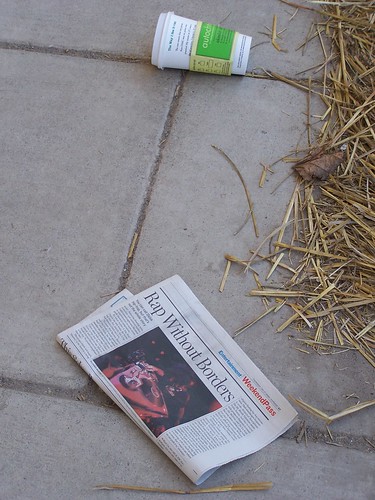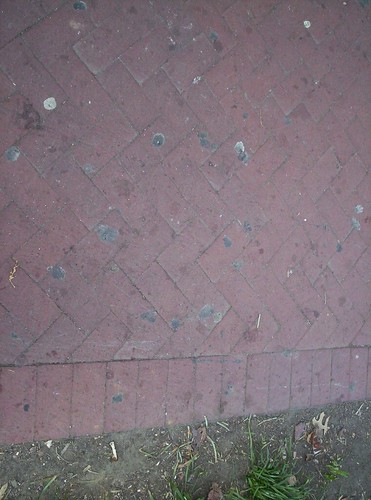Litter revisited
 This discarded cup was at 4th and L Streets NE, the nearest Wendy's is at New York and Florida Avenues, at least 3/4 of a mile away.
This discarded cup was at 4th and L Streets NE, the nearest Wendy's is at New York and Florida Avenues, at least 3/4 of a mile away.Last year, I wrote a long blog entry about litter issues, "Every Litter Bit Hurts," in response to a piece in the District Extra section, featuring the experience of a local resident in the H Street neighborhood. I've been thinking about this quite a bit for the past few weeks in the context of the "Commerz in the Hood" discussions in the H Street neighborhood, and with regard to successful commercial districts needing spiffy physical environments in order to be successful. (I mentioned it in the blog entry "The "soft side" of commercial district competition").
In the H Street neighborhood this has come up in terms of what I like to call the defense of squalor. People have been defending fast food and carryout establishments. I have no problem with low-priced food (today I ate lunch at Young's Deli in the Florida Market, eating once again Yook Ji Gae--$5.50 plus drink, and Wednesday I ate at Caribbean Superior on Route 450 in Bladensburg--$6.50 for excellent Jerk Chicken, the small portion, and I had leftovers...)
But there is no question that fast food and carryout establishments contribute tremendously to litter in the public space, just like consumption of alcoholic beverages in the public space often (not always, just like not every fast food restaurant patron litters) contributes to a menacing environment in our public places.
SO I have been paying even more detailed attention to litter on the street over the past few weeks, partly because people are saying that by selecting certain establishments over others for preference (i.e., coffee shops) you're "classcist," etc. I merely respond that I see very little trash from coffee shops, and lots from fast foods and carryouts. Is it that patrons of the respective establishments differ in terms of their concern about the broader environment ? Or is it something else?
 Finally! Starbucks trash. New York Avenue Metro Station. (The nearest Starbucks is blocks away inside Union Station.)
Finally! Starbucks trash. New York Avenue Metro Station. (The nearest Starbucks is blocks away inside Union Station.)I have found it quite interesting that I have detected many many instances of discarded coffee cups from places like McDonald's but only two instances of paper trash from coffee shops (one Starbucks, one Firehook). Granted, it hasn't been a systematic survey, but it is noticable.
As my friend Drew says, "People aren't empiricists." I am though...
While doing research I came across the work of the Keep Australia Beautiful campaign. Their National Litter Index is far more detailed and useful in comparison to the simple 1-4 (clean to dirty) scale used in the U.S. (I added this organization to the right sidebar earlier in the week.)
The Aussies track six broad categories:
• Glass
• Metal
• Plastic
• Paper / paperboard
• Miscellaneous
• Cigarette butts
and 70 subtypes total of these categories.
KAB/Australia does their survey nationally, so they can generate good data about the areas that are clean or particularly dirty and why. (The only factor I might suggest that they add to tracking is gum on sidewalks. Those of us who pay attention know why I suggest this.)
From a KAB press release:
Motorists are Australia’s worst litterbugs, throwing almost half the nation’s litter on highways and [parking lots], according to the results of a survey released today. The Australian Minister for the Environment and Heritage, Senator Ian Campbell, said the results of the Keep Australia Beautiful National Litter Index – funded by the Australian Government – showed 48% of Australia’s litter was found on highways, roads and in carparks.
"Smokers are the worst offenders," Senator Campbell said. "Cigarette butts account for almost half of all litter items with South Australia having the lowest proportion of butts (38%) and Victoria the highest (53%).
"Illegal dumping and uncovered loads also add to roadside litter. "You wouldn’t throw rubbish from your house window onto your front lawn, so why throw rubbish out of your car window onto the roadside or carpark?"
...The National Association Chairman of Keep Australia Beautiful, Don Chambers, said the top five types of litter found were:
• cigarette butts
• miscellaneous paper (including tissues)
• miscellaneous plastic
• snack bags and confectionery wrappers and
• metal bottle tops and can pull rings
"These results are not good news for the health of the environment and our nation," Mr Chambers said. "Litter is a symptom of the civil health of the nation. While the stain of urban graffiti alarms the community and leads to demands for tougher penalties – the litter at the bottom of the wall cannot be ignored. Too many people are relying on someone else to clean it up."
Makes me want to visit Australia even more...
 Pretty brick, dirty brick. 400 block, 8th Street SE, Washington, DC.
Pretty brick, dirty brick. 400 block, 8th Street SE, Washington, DC.I'm going to try to do a version of the Australian survey in Brookland.
Index Keywords: litter; quality-of-life-advocacy



0 Comments:
Post a Comment
<< Home